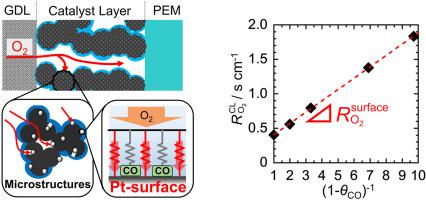Journal of Power Sources ( IF 9.2 ) Pub Date : 2020-11-13 , DOI: 10.1016/j.jpowsour.2020.229178 Shota Katayama , Seiho Sugawara

|
Reduction in the gas transport resistance in the immediate vicinity of the interface between the catalyst metal and the ionomer thin film is one of the primary challenges in achieving high-performance polymer electrolyte fuel cells with a low use of precious metals. In this study, a new electrochemical method was developed to evaluate the transport resistance separately from any other resistances in a porous electrode using only a single target sample. The transport resistance lying on the catalyst surface was evaluated from its inversely proportional dependence on the active surface area, which is controlled by an adsorbate that deactivates the catalyst surface; moreover, its coverage is quantifiable and controllable. After the coverage control, the limiting current technique provides the transport resistance of a catalyst layer. As a demonstration, an oxygen transport resistance lying on a Pt-surface in a Pt/C catalyst layer was investigated using CO as an adsorbate. The resistance lying on the Pt-surface was successfully evaluated from the CO-coverage dependence of the catalyst layer resistance. In particular for the reactant gas of oxygen, CO is not suitable for blocking the adsorbate over 40 °C, and another candidate that does not interfere with O2 is required.
中文翻译:

电化学方法定量测定聚合物电解质燃料电池中催化剂表面附近的气体传输阻力
降低催化剂金属和离聚物薄膜之间的界面附近的气体传输阻力是获得具有少量使用贵金属的高性能聚合物电解质燃料电池的主要挑战之一。在这项研究中,开发了一种新的电化学方法,可以仅使用一个目标样品就可以评估多孔电极中的传输电阻与其他任何电阻。根据其对活性表面积的反比例依赖性来评估位于催化剂表面的输送阻力,该活性表面积由使催化剂表面失活的吸附质控制。而且,其覆盖范围是可量化和可控制的。在覆盖率控制之后,极限电流技术提供了催化剂层的传输阻力。作为证明,使用CO作为吸附物研究了位于Pt / C催化剂层中的Pt表面上的氧气输送阻力。根据催化剂层电阻的CO覆盖率依赖性,成功地评估了Pt表面上的电阻。特别是对于氧气的反应气体,CO不适合在40°C以上的温度下阻止被吸附物,并且另一种不干扰O的候选气体2是必需的。



























 京公网安备 11010802027423号
京公网安备 11010802027423号